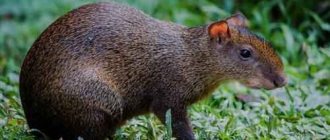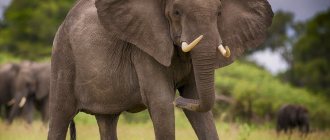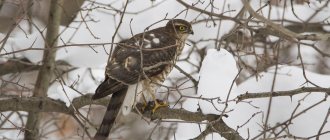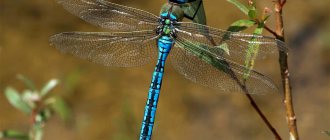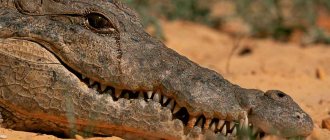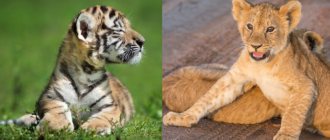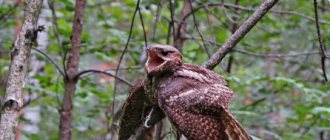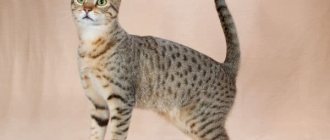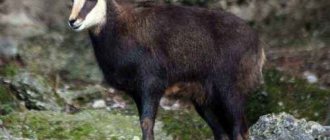Bear
A large, strong animal with dark brown or brown fur and clawed paws - everyone seems to know what a bear looks like. In fairy tales he has the “image” of being clumsy and clumsy. In fact, bears living in the forest are very dexterous, they can move almost silently - even run - and climb trees. Bears eat berries, nuts, fruits, oats and insects. They love to catch fish directly with their paws.
By the way, everyone knows the expression “suck a paw” - they usually say this, meaning “get by with little”, and sometimes “sit without money”. It is believed that bears suck their paws (literally) in their sleep when they are waiting out the winter in a den - in a hole covered with snow, under the roots of a fallen tree, or in a pile of brushwood. They don't actually suck - perhaps they just warm their paws with their breath.
The cubs are born blind in the middle of winter and emerge from the den in the spring, fed with the milk of their mother bear. In addition to the mother, the cubs are looked after by a nurse - that's what they call a nanny - the cubs' older sister. “Children” are usually playful, climbing trees and tumbling.
Nevertheless, it cannot be said that bears are so good-natured. This animal will not attack a person just like that, but if, for example, you disturb it in its den or if the she-bear decides that you pose a danger to the cubs, an unexpected meeting in the forest can end in disaster. Experts advise travelers to avoid dense bushes and thickets in the forest, if possible, talk loudly and sing while walking - this way you will not take the bear by surprise and avoid danger.
Wolf
The wolf that lives in the forest looks like a shepherd dog - not surprising, because it is from the wolf that all dogs trace their ancestry. But you can still distinguish a wolf: it is larger than a dog and never curls its tail into a ring. And he doesn’t bark, but howls or growls. His fur is gray or reddish, thick and warm.
In fairy tales, the wolf is considered a treacherous, formidable and evil animal. He received such “fame” because he is a predator - he feeds on the flesh of animals caught during hunting: roe deer, hares, foxes, badgers, mice, marmots, wild geese and others. Sometimes wolves even kill their own kind.
Berries, fruits and mushrooms are also included in the wolf's diet. Sometimes wolves steal watermelons and melons from farms - all because these animals are often thirsty: they have a high need for water.
Wolves hunt mainly in packs - and not where they live. Even if the wolf's den is located near a farm or village, the animals will not give themselves away, because they will hunt far away - perhaps kilometers - from the “place of residence.”
When you see a wolf in the forest, it is better to retreat quietly, without looking him in the eye, or leave altogether. At the same time, it should not be considered a “bad” animal - it is a dexterous, fast, smart and strong animal. Wolves are also good parents: she-wolves feed their cubs with milk and always protect them from danger. Wolf cubs are born deaf and blind, so at first they are completely defenseless. When they grow up a little, their parents bring them live prey - not only for food, but for play and passive “hunting”.
Fox
Dexterous, cunning and smart - this is how the fox appears before us in fairy tales and fables. Indeed, this animal often lives not far from people - not in a dense forest, but closer to the edge, and sometimes near fields and ravines - but does not give itself away. The fox is also very observant: for example, it is not afraid of dogs sitting on a chain, or people working in the field who do not notice it.
But if she is suddenly in danger, the fox disappears quickly, practically sprawling above the ground as she runs, and it is extremely difficult to catch her. When running and jumping, the fox's tail helps it maintain its balance - it is fluffy and red, sometimes white or black at the tip. The fox has red fur, a narrow muzzle, and black paws and ears.
Unlike wolves, foxes love solitude and do not gather in packs. They feed mainly on mice. In winter, foxes run through snow-covered fields and listen for a mouse squeaking somewhere so they can grab it. Foxes have excellent hearing, as does their sense of smell. But the vision is not very good.
Foxes also hunt hares, destroy bird nests, eat insects, snakes and frogs, and deftly carry chickens from farmers. And they don’t disdain berries and fruits.
Foxes breed in burrows. Moreover, sometimes they do not dig holes themselves, but are occupied by strangers - and at the same time they make backup passages just in case. The foxes feed their cubs - blind, deaf and toothless - with milk. Grown-up fox cubs are curious and do not stay in the hole for long - they are drawn to explore the surrounding space. True, they hide back in the hole at the first maternal “command” - yapping.
Foxes don't like meeting people too much, so if a fox suddenly approaches you on its own, this is a bad sign. Maybe she's mad. If there is no place to hide, try climbing the nearest tree, distracting the fox by throwing food (if you have it), or letting it grab onto a stick.
Squirrel
Squirrels are small, black-eyed animals that “change clothes” depending on the season. In winter, the squirrel is more fluffy, and the color of its coat is dominated by gray, black, and sometimes brown tones. In summer, the squirrel’s “clothes” are lighter—the fur is hard and short, usually red or brown. The luxurious fluffy tail serves the squirrel to maintain balance during long jumps. The squirrel's belly is white or light-colored.
Unlike most forest animals, squirrels can be found quite often - and not only in the forest, but also in the city park. They jump from tree to tree, and sometimes descend to the ground. If you don’t offend the squirrel, it won’t be afraid - and will even happily eat nuts or mushrooms from your hand. Yes, yes, many people don’t know about this, but squirrels love mushrooms - they even dry them for the winter, strung on a branch. Squirrels also extract seeds from spruce and pine cones, deftly gutting these cones with their paws. Foxes also eat snails and insects.
Squirrels sometimes build nests themselves - from twigs and twigs, moss and grass - and sometimes they “borrow” from crows and magpies. Squirrel nests are round and warm because all the holes are carefully plugged. Sometimes scraps of paper and clumps of wool found by squirrels are even used for these purposes. Squirrels do not limit themselves to one nest - they build several: for sleeping, for baby squirrels, in order to hide from enemies and bad weather. In extreme cold, several squirrels can hide in nests.
Squirrels can give birth twice a year and carry their young for just over a month. Baby squirrels appear tiny, no more than 5 centimeters, and blind. The mother feeds them with milk for 40–50 days (in the last of these days she accustoms them to berries, nuts and seeds). After 8–10 weeks, the baby squirrels already leave the nest.
Hedgehog
A narrow muzzle, a black nose, beady eyes, and most importantly, a “fur coat” with prickly needles. This is what this forest dweller looks like. The needles are needed so that the animal can defend itself from enemies - the hedgehog curls up into a prickly ball in case of danger. Basically, hedgehogs sleep in a hole or bushes during the day, and in the evening they lead an active lifestyle - they go out hunting. Sharp claws, spines and teeth help the hedgehog even catch a snake. Hedgehogs also eat insects, amphibians, caterpillars, worms, as well as fruits and berries.
They often live close to people - perhaps because we feed them. But you shouldn’t pet hedgehogs or pick them up - not only can you get hurt, but these animals are also carriers of dangerous diseases, including rabies. And you should not try to keep a hedgehog at home - it is a free animal.
Hedgehogs spend the winter hibernating in their burrow under tree roots, branches or stumps. The hole is prepared in advance when it starts to get colder. They drag grass, moss and leaves there to make it warm and cozy to sleep. And in the fall, hedgehogs feed intensively, accumulating fat for the winter.
Hedgehogs are born in the spring - like the cubs of many animals, they are toothless, blind and deaf. Hedgehogs feed their children milk and hide them under grass and leaves during their absence. After a year, hedgehogs become completely adult and independent.
Rainforests
Only a small fraction of tropical forest plant and animal species have been formally described and named. Therefore, only a rough estimate can be given of the total number of species contained in these ecosystems, as well as the number of species that have become extinct as a result of deforestation. However, it is clear that tropical forests contain more species than any other ecosystem on the planet.
Like plants, certain groups of animals are found throughout tropical forests. Other groups are more limited. Monkeys, typical of tropical forests in both the New and Old Worlds, are completely absent from New Guinea.
Tree kangaroos live in tropical forest canopies only in Australia and New Guinea. Birds of paradise are limited to the same areas. To a large extent, these geographic differences in tropical forest biota reflect the long-term geologic history of these ancient ecosystems.
Lynx
Meeting this large yellow-red forest “cat” with the famous “tassels” on its ears is a great success. Even hunters encounter lynx extremely rarely. At the same time, it does not pose a danger to humans, unless it is suddenly infected with rabies.
The lynx is flexible, dexterous and strong, and can climb trees and swim well. And deep snow is not a hindrance for her - because of her strong, furry paws. The lynx is also cunning - sometimes it checks the traps and traps of hunters before they themselves and drags away other people's prey. Sometimes it can wait for hours for a prey (hare, deer, roe deer, bird) in ambush, then quietly and unnoticed to sneak up and jump on it. If you can’t catch it the first time, the lynx can hunt for the same animal all day long. By the way, when entering the countryside, the lynx also hunts cats - almost their own kind.
Lynxes prefer to settle in secluded places - for example, in holes under trees. They are not shy about occupying other people's holes.
Lynx cubs are furry and blind for the first few days. By the way, both parents raise lynx cubs, and this is a rather rare case in the animal environment.
Octopus blanket
The blanket octopus has 3 hearts and a membrane between its tentacles that allows it to fly in water. For this property, the mollusks were called soaring octopuses.
Only females have a bright blanket - it is used to scare away enemies. The individual straightens its mantle, due to which it increases in size to almost 2 meters. Female octopuses weigh up to 10 kg. For comparison, the male is 2.5 cm long and weighs 250 g.
If the blanket does not work, the amazing creatures infect the enemy with deadly poison. Their habitats are the coasts of the Pacific and Atlantic oceans, the seas of New Zealand, and the Barrier Reef in Australia.
Hare
In fairy tales, we are used to seeing the hare as cowardly and stupid. In fact, this is an intelligent and nimble animal that can throw both a fox and a person off the scent. Perhaps the hare is considered cowardly because he often hides in the grass or bushes, catching a sound that alerts him with his large ears, and with quick long jumps runs away from enemies who still managed to detect him. Sometimes the hare suddenly returns in its own tracks and jumps far to the side - so there are more tracks, and it is no longer clear where the animal went.
The hare's eyes are located on the sides of its head, which is why it is called “slanty”. But thanks to this feature, he can see what is happening not only in front of him, but to the side and even behind.
The snowshoe hare turns white in the winter to blend in color with the snow. The brown hare, which lives in the fields and steppes, is gray all year round, and by winter it also brightens, but not so significantly.
The main enemies of hares are foxes, wolves and birds of prey. During the day, in the light, the hare hides from them alone, and comes out to eat in the evening or before dawn. Hares feed on grass, branches, plants, and in winter, tree bark. Crops from gardens are often stolen.
Hares have sharp teeth and long, sharp claws. Contrary to stereotypes, it happens that wild hares kill foxes, and not vice versa. Sometimes a hare can even rush at a person, but only for self-defense. If you don't offend the animal, it will most likely simply hide when it sees you.
The little hares feed on their mother's rich milk, but if she suddenly leaves on business, then they feed on the milk of another hare. They grow quickly.
↑ Family
Animals from genera with the same origin and similar in appearance constitute one family. Numerous families are formed by subfamilies. The name of the family comes from the genus: cats are part of the feline family; the deer family includes: elk, deer, musk deer, reindeer and American deer.
Often the family name displays:
- Appearance of animals: family of Fantail birds or family of Whitefly butterflies.
- Or habits: the family of spitting spiders or orb-weaving spiders.
- Some names suggest the animal's lifestyle: the family of Water striders or Dart frogs.
Boar
Powerful and strong fanged boars, the ancestors of pigs, look menacing and are therefore considered very dangerous. In fact, a healthy boar, like many other animals, can attack a person only if there is a need to defend itself or protect its cubs. But wounded and sick boars are really aggressive and unpredictable. Be that as it may, you can’t run away from them, just like you can’t come closer, look into their eyes, or turn your back. When meeting a wild boar, you should behave calmly. But, most likely, the meeting will not happen - the boar will hear you from afar and leave on its own.
This animal runs quickly - the structure of its hooves allows it to overcome even swamps without getting bogged down - and swims across any rivers. But it is difficult for a wild boar to move in deep snow. At the same time, he does not freeze in cold weather - by winter he develops a thick undercoat and accumulates fat.
Wild boars live in small groups. They eat hazelnuts, seeds, acorns, plant tubers, and enjoy mushrooms, berries, apples and pears. Sometimes they dig up potatoes or turnips from summer cottages. Piglets are given birth in a den hidden by moss and branches. On the backs of the babies there are light stripes, because of which the cubs are not visible among dense thickets and in bright light, as well as in the shade.
Like pigs, wild boars love to bathe in mud - this is how they escape the heat and get rid of insects clinging to their coarse fur.
African Cats: Kingdom of the Brave
African Cats
- USA, 2011.
- Documentary.
- Duration: 89 minutes.
- IMDb: 7.6.
This breathtaking film was commissioned by Disneynature, a subsidiary of Walt Disney Studios. With the voiceover of Samuel L. Jackson, viewers will learn the life story of a pride of lions, led by the experienced lioness Leila. The second part of the film tells the story of Sita, a female cheetah with many children, who is heroically trying to protect her cubs from the dangers that lurk in the savannah teeming with predators.
Watch on iTunes → Watch on Google Play →
Elk
Elk is just as large and powerful, but, according to many, not as luxurious an animal as deer. Also wide horns (protection from wolves and bears), but - a hump on the nose, a thick upper lip, a massive body with a “hump” that forms the scruff of the neck... And also long ears, thick warm fur and large hooves.
Thanks to these features, moose do not freeze in winter, hear perfectly, move through deep snow, can swim and run quickly - including through dense forests and swamps.
Moose feed on everything they find in the forest: leaves, bark, branches, pine needles, moss, mushrooms, berries and plants growing near water. By the way, moose love to swim, especially in the heat.
In winter, moose shed their antlers to grow new ones in summer.
In the spring, moose cows give birth to cubs, feed them milk and lick their fur. Moose milk is considered healthy. When a moose cow walks with a “child,” it is better to avoid her: in order to protect the calf, she may attack.
Moreover, there are even moose farms where moose are milked - that is, they can actually be tamed.
Moose can be found not only in the forest - it can even wander into a city park (for its love of walking, it is called a tramp). As with other wild animals, the main thing is not to attract attention to yourself, do not get close or run away.
Are you learning English with your child? In this article we have compiled a list of animals in English for grades 2-3 with translation, transcription in Russian letters and colorful illustrations. And simple riddles about animals will help you consolidate your knowledge.
Brownie shark
The shark belongs to the Scapanorhynchidae family and today is its only representative. Scientists jokingly call the predator a “living fossil,” since more than 125 million years have passed since its ancestors appeared on the planet.
The unusual shark was first caught in Japan in 1897. The fish, with its heavy body, elongated snout, long caudal fin and beak-like jaws, was unlike any species known at the time.
Her body was covered with transparent skin, through which the vessels were clearly visible. The fishermen named the shark “tengu-zamu,” which means “brownie” in Japanese.
At the University of Tokyo, a goblin shark lived for less than a week and died. The predator is considered elusive - from 1897 to the present time, 45 cases of its successful capture are known.
The jaws are the most valuable - connoisseurs of outlandish things pay several thousand dollars for them. The fish has no commercial value.
Wolverine
This animal is a kind of cross between a sable, a badger and a bear, and is the size of a dog. Powerful head, sharp teeth, thick clawed paws.
Despite his somewhat clumsy appearance, wolverine is flexible, agile and strong. And it is quite cruel - it attacks sick animals, destroys nests, and often feeds on carrion. Its diet also includes snakes, lizards, and fish (the wolverine is an excellent swimmer). It is protected from enemies by iron with a nasty smell, with which it scares off larger animals so much that sometimes they not only do not attack, but even throw their own prey to the wolverine. She also willingly “cleans up” traps and pitfalls set by hunters. Yes, even a loud picnic, especially at night and with attractive aromas of food, may well be visited.
However, she is also capable of hunting herself - she has acute hearing and vision, a quick reaction, and is able to pursue even a large deer for a long time and persistently, and then attack from behind. If an animal, even many times larger than the wolverine itself, is weak and sick, she will not leave him a chance. The wolverine goes hunting at night - it can navigate perfectly in the dark.
The lair is made under the roots of an uprooted tree or away from prying eyes. Doesn't stay anywhere for long, constantly on the move.
Wolverine cubs are born at the end of winter, and in the summer they follow her on a long journey. Their mother skillfully teaches them to hunt and protect themselves from enemies. It is better not to approach wolverine cubs - the mother can attack a person while protecting her offspring. At the same time, once a wolverine puppy gets to a person, it will probably get used to it and become obedient.
Beaver
For many centuries in a row, the largest rodent in Russia - the common beaver - was a target for hunting: people were attracted by its skin, meat, fat and even secretions of the musk gland, which have healing properties. It was easy to find beaver settlements, since the animals settled in groups of 5–8 animals, often near the water. Over time, the beaver population has thinned out.
The beaver is a squat, densely built animal, its body length is about a meter, its fur color ranges from chestnut to dark brown, less often black. A beaver's hind legs are much stronger than its front legs.
Smart, hardworking beavers love to build holes or huts from branches, sticks, clay, silt, and always with an exit under water. In the aquatic environment, these hard workers are more comfortable and safer, and on land they move less willingly. The beaver also stores its reserves in the water, not far from the hut, and in winter it gets enough so as not to go onto land.
Dams built by beavers prevent water bodies from drying out. And beavers need dams to raise the water level and make their homes comfortable.
Beavers are herbivores - they eat more than 300 species of plants. They love tree bark and coastal water lilies and reeds. With its sharp teeth, a beaver can even gnaw through a tree, and sharpens them on some types of trees.
Beaver cubs are born in April-May, and there can be up to six of them in a litter. At first they feed on mother’s milk, after a couple of weeks they can already eat plants, and over time they switch to plant foods completely.
Despite the fact that newborn beaver cubs already have good vision, are covered with warm down, can swim and have teeth, beavers live with their parents for up to two years.
The beaver is generally not dangerous to humans. Bites extremely rarely. And yet, you shouldn’t try to feed it or take a photo - when you meet an animal, it’s wiser to stand and wait for it to swim away.
boreal forests
Almost all major groups of plants and animals in the taiga are less diverse than in other terrestrial ecosystems at lower latitudes. This is consistent with a gradient in species diversity observed from lower to higher latitudes, with the number of species decreasing towards the poles.
Since stable winter snow cover is a feature of the taiga, several species of mammals show obvious adaptation to the environment. Hares undergo seasonal changes in coat color from brownish or grayish in summer to white in winter, providing effective camouflage.
The legs, which are large relative to the size of the body, allow the hare to move through the snow rather than sink into it. The lynx is the hare's main natural predator, and also has large paws, with fur between the toes, allowing the animal to remain on the surface of the snow. Most animals in the boreal forest are well adapted to the cold and survive easily if they have enough food to maintain energy balance throughout the winter.
Moose are the largest animals in the taiga. In the summer they eat willows and broadleaf trees, and also enter lakes to consume aquatic plants. Throughout the winter, moose eat large quantities of tree branches and buds. Moose populations are controlled by wolves, who hunt them in much of the boreal forest.
Other large ungulate mammals present in the taiga are the reindeer in Eurasia and the closely related caribou in North America. Reindeer populations are subject to partial domestication by nomadic peoples such as the Sami in Scandinavia and other indigenous peoples in northern Russia.
Some boreal forest mammals are prized for their fur. Trapping and trading fur was an important part of the region's culture, economy, and history. Important fur-bearing species include lynx, marten, as well as beaver, mink and muskrat.
In the North American taiga, the northern flying squirrel has adapted to consume fungi, especially underground fruiting bodies that form mutualisms with trees by colonizing their roots. The consumption and distribution of these mushrooms provides significant benefits to the forest as a whole.
The taiga is a migration site for a large number of migratory birds during the summer breeding season. These include passerines and songbirds typical of bush and forest habitats, such as blackbirds, flycatchers and nightingales. Many of these species consume insects in the forest canopy. Birds of prey include species such as the barred hawk and the goshawk. Populations of taiga migratory blackbirds, flycatchers and nightingales are declining due to the loss of wintering grounds in tropical forests, and the destruction of forest habitats in temperate zones along their migratory routes.
Birds of the boreal forest fill a variety of niches. Some consume seeds, others feed on insects. Due to limited feeding opportunities in taiga areas, few bird species remain during the long, cold winters, although some make only a short migration south. Vast areas of lakes, ponds, and wetlands provide habitat for waterfowl and shorebirds. However, birds are found in low densities throughout the landscape.
Boreal forests are home to relatively few insect species. Perhaps the most noticeable insects to humans in the taiga are mosquitoes, which are represented by several species. Coniferous trees provide shelter for a variety of tree beetles. These insects help decompose wood and release nutrients.
Ermine
This small, cunning, nocturnal animal is very difficult to spot: the yellowish-brown color of its coat in summer allows the ermine to blend in with trees and plants, and its white coat in winter allows it to blend in with the snow (however, the tip of this animal’s tail is always black). The ermine has someone to hide from: foxes, sables, wolves, birds of prey - they are all its enemies.
Thanks to camouflage, the ermine can live not only in forests, but even near people. The predator prefers places where there are a lot of frogs, fish, mice and birds, whose nests it often destroys. The stoat sometimes catches more rodents than it needs for food, so it leaves reserves for the winter.
Stoats, like most animals from the mustelid family, have a long body (up to 40 centimeters), round ears and short legs, due to which stoats move mainly by jumping. They can climb trees and swim too, but they prefer to walk on the ground.
Stoats are loners. They settle near bodies of water - in a hollow, and often in someone else's hole (they do not build their own houses). At the same time, they themselves do not allow anyone into the territory they occupy, “marking” them with their scent. A trespassing animal will most likely face a confrontation. And it’s better not to come close to a person - if he is driven into a corner or gets angry, the stoat will not be afraid to attack.
There are a lot of cubs in an ermine litter - up to 20. Moreover, the pregnancy of an ermine sometimes lasts longer than that of a human - up to 10 months. Animals build nests while raising their offspring - often in their own burrow or pile of dead wood. The inside is softly lined with bird feathers, down and the hair of small animals. The cubs are born tiny - a few grams, blind, deaf and without teeth.
A caring mother in the first days of her children’s life almost never leaves the nest, and in case of danger she carries the entire brood in her teeth and even swims with the cubs short distances on the way to a new shelter. Stoats feed on their mother’s milk for two months, but then spend several months next to her, learning to hunt from her.
Short, thick fur made from ermine skins is very expensive. Ordinary people cannot afford ermine outerwear. Even the Queen of England is only allowed to have one ermine robe. Due to hunting of these animals, their numbers are decreasing.
Back in the Middle Ages, people tried to tame stoats, but little came of it. The animals generally grow up wild, even if they were born in captivity, and they also attack other domestic animals: hamsters, fish, tame mice.
Amphibians
About 30 species of amphibians have been recorded in Russia, which is less than 1% of the world's diversity.
Common toad
These toads secrete small amounts of toxins to protect them from most predators, although the poison does not stop snakes and hedgehogs. If they are lucky enough to avoid voracious predators, common toads can live up to 40 years.
lake frog
Lake frogs spend all their time directly in the water, or at a distance of several jumps from the reservoir. They are good swimmers and jumpers, often just standing in the mud, ready to jump into the water at the first sign of danger.
Crested newt
A relatively large species of newt. Females are larger than males and can reach 16 cm in length. Crested newts have gray-brown backs and sides, and are almost entirely covered in dark spots. Males are distinguished from females by the presence of a serrated crest during the breeding season.
Siberian salamander
The Siberian salamander is the only amphibian species found within the Arctic Circle. This unique amphibian is capable of replacing water inside the body with glycerol, which allows it to survive long periods of hibernation at temperatures below -35° C.
Sable
Sable hunting has long been widespread in our country. Sable skins (sable fur is thick, delicate, warm and looks luxurious, especially in winter) were presented by the tsars as gifts to eminent foreign guests. Now hunting has significantly reduced the number of sables, and they can be seen extremely rarely.
These beautiful fast animals live in old stumps and tree hollows not high above the ground. Sables are dark brown or light brown, with a yellowish spot on the chest and neck, round ears, wide paws and a bushy tail.
Sables climb trees well, but mostly move on the ground or trunks of fallen trees and snags. In winter, the sable does not hibernate, it only waits out bad weather in a shelter. The animal can also run under the snow - its fur coat is warm, and enemies will not reach you there. And it’s convenient to hunt - sables go hunting both during the day and at night. Their main prey are mice, moles, and shrews.
Sables strictly divide hunting territories between relatives. If an opponent encroaches on his territory, the animal can enter into a fight with him.
Sable cubs are born in the spring, feed on their mother's milk and remain blind for a whole month. The father brings food to the kids. Only in the fall do sables begin to live and hunt on their own.
The sable does not attack a person first, but there is still no need to provoke him. The animal may perceive unnecessary attention as danger.
Bay
The Cove
- USA, 2009.
- Documentary.
- Duration: 92 minutes.
- IMDb: 8.4.
Director Louis Psihoyos' investigative documentary explores the complex subject of Japanese whaling and its horrors. Every year, residents of the village of Taiji catch dolphins to sell to aquariums. However, most animals are still killed to sell the meat in markets.
Psihoyos' project received an Oscar in the category "Best Feature Documentary".
Raccoon
This cute-looking animal is easy to distinguish by the black stripe on its face through the eyes, reminiscent of a mask, and dark stripes on its fluffy tail. A raccoon is similar in size to a dog; its fur is always thick and long. Raccoons can swim and climb from branch to branch - their legs are dexterous and tenacious. The animals skillfully “fish.” Before eating, the striped raccoon - the most famous species of raccoon - rinses food in water with its front paws. Sometimes he even bathes his cubs this way.
Raccoons are born blind in the spring. After two months of feeding with mother's milk, they become stronger and leave the hole, but do not go far from their parents all year.
You can meet a raccoon not only in the forest, but in the village, at the dacha and even within the city - especially on the side of the road. They can climb quite far in search of food. Sometimes they live in barns and sheds, in the hayloft. They prefer solitude, but in winter they can sleep in burrows or hollows with whole families.
It is better not to approach a wild raccoon - it can bite even for no reason, and also carries rabies and tetanus. If a raccoon wanders into your dacha and steals your crops, he should leave the food slightly away from the house. Then the raccoon will be kinder and stop stealing your berries and fruits.
Raccoons are quite trainable, so they can be seen in the circus.
Weasel
This flexible animal with a thin long body and short legs moves funny - by jumping. Weasels have small round ears, a blunt nose that slightly forks at the end, and sharp claws. The top of the head, back, sides, tail and paws on the outside of the weasel are brownish in summer, and the throat, chest, abdomen and paws on the inside are white. In autumn, the animal “changes clothes” into completely white fur.
The weasel is similar in appearance to the ermine, but is smaller and has a single-colored, shorter tail that lacks the black tassel.
Weasels often live in colonies - in hollows, burrows, under stones. They do not avoid populated areas, but do not attract attention to themselves and rarely make sounds. But they hiss when they are in danger, and “chirp” when they attack.
The weasel is a fast, aggressive and bold predator. She hunts day and night, mainly on small animals: mice, rats, jerboas, moles, rabbits, chickens, pigeons. And also on lizards, insects and even snakes. The weasel itself, thanks to its agility, can sometimes fight off even a large predator.
The cubs are carried for 5 weeks and given birth in mid-spring. If they are suddenly in danger, the caress in the teeth will carry them to another place.
By the way, in Ancient Rome and even early medieval Europe, weasels were pets and protected their owners’ supplies from mice. But the weasel is difficult to tame, and it was more difficult for her to cope with the gray rats that appeared in Europe later. Therefore, the weasel was replaced by other domestic animals, including cats.
Weasels do not attack humans, but, like many wild animals, they can serve as carriers of dangerous diseases.
Wildlife Habitats and Evolution
African savannah
Wild animals have an amazing ability to adapt to environmental conditions. They inhabit the entire globe from the South Pole to the North Pole. The ability of animals to adapt to the world around them is called adaptation. Evolution helps them survive - a natural process of selecting the strongest representatives of the species. She can greatly modify creatures to suit their survival. For example, some species of dinosaurs evolved to become modern birds. This helped them survive.
Deer
There are many varieties of deer. Although we are accustomed to imagining a beautiful large animal with branched horns, there are also spotted ones - smaller ones, and even very small ones - the size of a cat. By the way, only males have horns. Every year they shed their antlers and new ones grow in their place.
The deer has slender legs and large round eyes, thanks to which the animal has excellent vision. The sense of smell and hearing are also very acute.
Deer live in herds - not only in forests, but also on mountain slopes, in thickets of bushes, and in clearings with tall grass. In hot weather they like to swim to escape the heat and midges. They love salt and regularly visit salt licks.
Wolves hunt deer. Strong hooves and antlers usually help a healthy deer fight off an attacker. The deer themselves are quite peaceful - they feed mainly on berries, mushrooms, grass, nuts, chestnuts, bark and branches.
Autumn is mating season for deer. During this period, in some forests at dawn you can hear the unique roar of a red deer for kilometers away. It resembles either playing a trumpet, or the mooing of a cow, or loud sighs. Deer are born spotted (in adult deer the spots disappear) and often with a light spot near the tail. Newborn fawns lurk in the grass while their mother grazes nearby. The doe communicates with the fawn by “bleating.”
In general, deer rarely chase people, but they become more aggressive during the “wedding” period.
Hunting for sika deer is prohibited. At the same time, pantocrine is made from deer antlers - a medicine that helps with neurasthenia, asthenia (a state of weakness, exhaustion, increased fatigue) and so on. And in the East it is believed that pantocrine helps preserve youth and strength.
